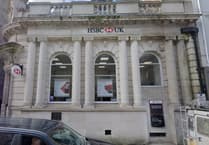A plaque has been unveiled by Welsh Government Minister, Jayne Bryant, to celebrate the re-opening of Cardigan’s heritage market following extensive restoration and modernisation.
This £3 million project was led by Cardigan Building Preservation Trust and funded in particular from the Welsh Government’s Transforming Towns programme and by Ceredigion County Council. Menter Aberteifi Cyf., a not for profit community business, manages Cardigan Market for the Trust.
The Cabinet Secretary for Housing and Local Government, Jayne Bryant, said: "It was a pleasure to attend the official reopening of Cardigan Market Hall and to see its incredible transformation.
“The market hall is a significant part of the town’s rich history and this restoration project is the perfect example of how our Transforming Towns programme is being used across Mid Wales to breathe new life into empty buildings while maintaining their unique characteristics and architecture.
“With updated facilities and new opportunities for market traders and entrepreneurs, the market hall will continue to be a vibrant hub for the local community and visitors to enjoy.”
Councillor Clive Davies, Ceredigion’s Cabinet Member for Economy and Regeneration, said: “It was great to be a part of the re-opening of the market hall today. The completion of Cardigan Market Hall works signifies a major addition in the town's regeneration. This building, as well as being a space for small businesses to develop and grow, thus securing its long-term future and sustainability for market traders and opportunities for new enterprises, it also has significant heritage value.”
The work on the building to address severe water incursion has included a renewed Welsh slate roof and major repairs to the walls and floor. A new underfloor heating system has been installed together with solar panels, and an upgraded electrical system. A completely new entrance block at the rear has improved access direct from the car park to both market floors and the High Street, and has included a lift and public toilets. Market stalls have all been renewed, improving facilities for traders as well as the local community and visitors.
.jpg?trim=0,2,0,1&width=752&height=500&crop=752:500)
The project has safeguarded traders’ livelihoods and provided trading opportunities for new businesses. Since July last year when the building was re-occupied, business in the market has been very successful with all available stalls tenanted and visitor numbers up.
Transforming Towns is a Welsh Government programme providing £125 million to town centre regeneration in Wales. Town and city centres are an essential and personal part of Welsh heritage and community, and the Transforming Towns programme is dedicated to serving and connecting the people who live, work, learn and spend leisure time in them.
Additional support for this project was secured from the Coastal Communities Fund, the National Lottery Heritage Fund, the European Union’s Agricultural Fund for Rural Development, Cadw, the UK Government’s Levelling Up Programme, the Architectural Heritage Fund and by way of a Ceredigion Community Grant.
The changes were designed and supervised by a team of professionals headed by Peter Holden Architects Ltd and managed by Hurley and Davies Ltd, Chartered Surveyors. The main building contractor was Jamson Estates Ltd.
Cardigan Market was built in 1860 in the 'Ruskinian' Gothic style that followed the precepts laid down by the great Victorian visionary, John Ruskin. The building’s conservation listing is Grade ll* (a Grade II building of particular importance), as one of the first civic buildings in the UK to follow Ruskin's precepts. It has been in use as a general market ever since it was built.
Cardigan Building Preservation Trust is a registered charity run wholly by local volunteers. Its object is the preservation of buildings of historical or architectural merit for the public benefit in the Cardigan area.
The trustees’ previous project completed in 2012 was the restoration and modernisation of Cardigan Guildhall and its courtyard. The Guildhall is attached to Cardigan Market on one side and was constructed at the same time to the same Ruskinian principles.




.png?width=209&height=140&crop=209:145,smart&quality=75)